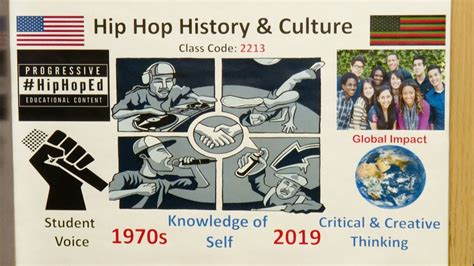History Of Hip Hop Culture

Hip hop, a cultural phenomenon that originated in the Bronx, New York City, has evolved into a global force, shaping music, art, fashion, and youth culture for decades. Its origins can be traced back to the 1970s, where it emerged as a vibrant and dynamic expression of the African-American and Latino communities, providing a voice to the marginalized and a platform for creative self-expression.
The Birth of Hip Hop: A Cultural Revolution

The early 1970s saw the emergence of a new genre of music and a cultural movement that would forever change the landscape of popular culture. Hip hop, as we know it today, was born in the South Bronx, an area characterized by its diverse and vibrant community, yet plagued by poverty and urban decay. It was within this context that the four fundamental elements of hip hop began to take shape: MCing (rapping), DJing, breakdancing, and graffiti art.
One of the key figures in the early development of hip hop was DJ Kool Herc, a Jamaican-American DJ who is often credited as the "father of hip hop." Herc, whose real name is Clive Campbell, pioneered the use of turntables as musical instruments, a technique that would become the foundation of hip hop music. He developed a style of DJing known as "break-beat deejaying," which involved isolating and repeating the percussion break (or "breakbeat") of a song, creating a continuous and rhythmic beat for dancers and rappers.
Herc's innovative DJ sets, which often featured live MCs (rappers) and breakdancers, quickly gained popularity in the Bronx and laid the groundwork for the hip hop culture we know today. These early hip hop parties, or "block parties," provided a safe space for the community to come together, express themselves, and escape the hardships of their daily lives.
The Power of the MC: The Voice of Hip Hop
As hip hop evolved, the role of the MC (Master of Ceremonies) became increasingly important. MCs, or rappers, used their lyrical prowess and storytelling abilities to capture the experiences and struggles of their communities. Early hip hop MCs like Grandmaster Caz, Melle Mel, and Kool Moe Dee delivered powerful and witty rhymes, often in the form of battles, where MCs would engage in verbal sparring, showcasing their skills and wit.
The lyrics of these early rappers were a reflection of their surroundings, addressing social issues, celebrating their culture, and offering a unique perspective on life in the inner city. Their words, delivered with rhythm and precision, resonated with a generation of youth who saw themselves and their experiences represented in this new art form.
| Early Hip Hop MCs | Notable Contributions |
|---|---|
| Grandmaster Caz | One of the pioneers of hip hop, known for his smooth delivery and storytelling abilities. |
| Melle Mel | A member of the legendary group Grandmaster Flash and the Furious Five, he is often credited with being one of the first socially conscious rappers. |
| Kool Moe Dee | A renowned battle rapper and a member of the group Treacherous Three. His skill and technique influenced a generation of MCs. |

Breaking Boundaries: The Evolution of Hip Hop Dance
Breakdancing, or “breaking,” is an integral part of hip hop culture, and its origins can be traced back to the same block parties where DJ Kool Herc was spinning his records. This high-energy dance style, characterized by its intricate footwork, spins, and power moves, was a form of self-expression and a way for youth to channel their energy and creativity.
Breaking gained mainstream attention in the 1980s, with the rise of hip hop music and its associated culture. Films like Beat Street and Breakin' brought the art of breaking to a wider audience, showcasing the talent and athleticism of these dancers. Breaking competitions, or "battles," became a popular way for dancers to showcase their skills and gain recognition within the hip hop community.
The Golden Age of Hip Hop: A Creative Explosion

The 1980s and early 1990s are often referred to as the “Golden Age” of hip hop. This era saw an explosion of creativity and innovation, with artists pushing the boundaries of the genre and establishing hip hop as a legitimate art form. The music industry began to take notice, and hip hop began to gain mainstream popularity, with artists like Run-D.M.C., Public Enemy, and N.W.A. achieving commercial success and critical acclaim.
The Golden Age was characterized by a diverse range of styles and themes. Artists like De La Soul brought a more light-hearted and playful approach to hip hop, incorporating elements of funk and soul, while groups like A Tribe Called Quest and The Roots explored more thoughtful and intellectual themes, delving into social and political issues.
The Hip Hop Renaissance: A New Wave of Innovation
In the late 1990s and early 2000s, hip hop experienced a resurgence, often referred to as the “Hip Hop Renaissance.” This period saw a return to the genre’s roots, with artists focusing on lyricism, storytelling, and social consciousness. Artists like Nas, Jay-Z, and Eminem rose to prominence, delivering complex and thought-provoking lyrics that addressed issues of race, identity, and social injustice.
The Hip Hop Renaissance also witnessed the rise of female artists, such as Lauryn Hill, Missy Elliott, and Queen Latifah, who brought a unique and powerful perspective to the genre. These artists challenged gender norms and broke barriers, establishing themselves as some of the most influential figures in hip hop history.
The Global Impact of Hip Hop
Hip hop’s influence extends far beyond the shores of the United States. The genre has become a global phenomenon, with artists and fans from all corners of the world embracing and adapting the culture to their own unique contexts. Hip hop has served as a powerful tool for social and political expression, with artists from countries like France, Germany, and Japan using the genre to address issues relevant to their own societies.
The global reach of hip hop has also led to the development of unique regional styles, such as K-pop in South Korea, which incorporates elements of hip hop and has gained a massive following worldwide. Additionally, hip hop has influenced fashion, with its distinctive style of baggy clothing, sneakers, and accessories becoming a global fashion trend.
The Future of Hip Hop: A Continuous Evolution
As hip hop continues to evolve, it remains a powerful force for cultural expression and social change. The genre has proven its resilience, adapting to new technologies and incorporating elements of other musical genres. The rise of streaming platforms and social media has given independent artists a platform to showcase their talent, fostering a more diverse and inclusive hip hop landscape.
Looking ahead, hip hop is poised to continue its evolution, with artists pushing the boundaries of creativity and incorporating new sounds and styles. The genre's ability to reflect the times and provide a voice to the marginalized ensures its relevance and impact for generations to come. Hip hop's journey, from its humble beginnings in the Bronx to its global dominance, is a testament to the power of music and culture to unite and inspire.
FAQs
What are some of the key elements of hip hop culture besides music?
+
Hip hop culture encompasses more than just music. The four fundamental elements include MCing (rapping), DJing, breakdancing, and graffiti art. These elements together form a holistic expression of hip hop culture, with each playing a crucial role in the overall experience.
How has hip hop influenced fashion and style?
+
Hip hop has had a significant impact on fashion, introducing a unique style characterized by loose-fitting clothing, bold colors, and iconic accessories like sneakers and baseball caps. This style, often referred to as “streetwear,” has become a global trend, influencing high-fashion designers and everyday wear alike.
What is the role of sampling in hip hop music production?
+
Sampling is a crucial technique in hip hop music production, where producers take snippets of existing recordings and incorporate them into new tracks. This practice has allowed hip hop artists to pay homage to their musical influences, create unique sounds, and push the boundaries of musical innovation.



